Quitclaim Deed Template
This Quitclaim Deed is executed on [Date], in accordance with applicable laws of the state of [State Name].
This Deed, made between:
Grantor: [Grantor's Full Name], residing at [Grantor's Address]
and
Grantee: [Grantee's Full Name], residing at [Grantee's Address]
Hereby conveys, sells, and transfers the following described property:
Property Description: [Legal Description of Property]
The Grantor hereby relinquishes all rights, title, and interest in the aforementioned property to the Grantee.
This deed is to be recorded in the office of the [County Recorder's Office] of [County Name] County.
IN WITNESS WHEREOF, the Grantor has executed this Quitclaim Deed on the date first above written.
______________________________
Grantor's Signature
______________________________
Grantee's Signature
State of [State Name]
County of [County Name]
On this [Date], before me, a Notary Public in and for said County and State, personally appeared [Grantor's Full Name], known to me to be the person whose name is subscribed to the within instrument, and acknowledged that he/she executed the same.
WITNESS my hand and official seal.
______________________________
Notary Public Signature
My commission expires: [Expiration Date]
